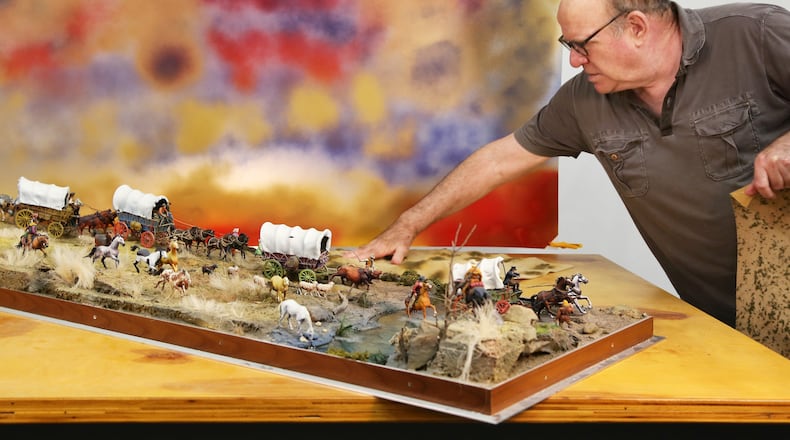To see how Levinthal transforms shelves of toys into stunning photographs, you’ll want to visit the special exhibition that opens at the Dayton Art Institute this weekend. “American Myth & Memory: David Levinthal Photographs,” comes to the Miami Valley, courtesy of the Smithsonian American Art Museum’s traveling exhibition program, Treasures to Go.
The show consists of 74 color photographs created between 1984 and 2018 and donated by the artist to the Smithsonian American Art Museum. The images on display at the DAI are drawn from six of Levinthal’s most well-known series — ”Modern Romance,” “American Beauties,” “Barbie,” “Wild West,” “Baseball” and “History.”
Credit: Mana Capture
Credit: Mana Capture
DAI chief curator Jerry Smith says he is especially excited about the exhibit because he’s been following Levinthal’s work for years. “He takes something that many would consider frivolous– toys–and uses them to create fine art,” explains Smith. " Levinthal creates vignettes using toys, then using soft focus, he takes photographs that suggest a real scene. He is making commentary on how the toys we play with as children help shape who we are as adults.”
Smith says the colorful images, most often in special large format Polaroid film, speak to nostalgia, longing, memories and myths of our collective past. “They are both fun and serious simultaneously, and we see how he has developed over the last four decades within the exhibition.”
Meet David Levinthal
“I used to say there is less in my photograph than meets the eye,” Levinthal said in a recent telephone conversation.” What I meant is that I want people to immerse themselves in the image and have it merge with some of their own stored images to create dialogue with the photograph and have it resonate with them in some way.”
He says his Western photo provides one good example. “Everybody who looks at it has so many Western images already in their mind from movies or TV,” Levinthal explains. Another good example is the JFK assassination photo. “Everybody remembers that moment,” he says. “The object I photographed is a little toy car that’s less than five inches long with these six small plastic figures in it. What makes that picture work is Jackie’s hat. You instantaneously recognize that and so you’ll also know who the other figures are and where you are as a viewer. The ultimate goal of what I’m looking for is to make work interactive.”
On a typical day, after feeding and walking his dogs –CJ and Ringo– Levinthal heads to his New Jersey studio “where all my toys live.” He has three shooting tables set up and says he may be working on a couple of different scenes simultaneously. “I leave myself notes of things I want to try in a scene that I’m already shooting,” he explains. “Because I’m shooting digitally, I can see everything right away.”
How he got started
Levinthal describes himself as an obedient child who grew up in California as one of four children. “My father was a research scientist and had an annual science meeting in Europe so I first went abroad when I was 13,” he says. " I remember visiting the Louvre; I enjoyed seeing the art but being an artist was nothing I’d thought about. I was going to be a constitutional lawyer.”
He got his first camera for a high school trip to Eastern Europe in the summer of 1963. “One of our neighbors had given me one of the early Polaroid black-and-white cameras. You had to wipe the print after you peeled it apart and it was incredibly fascinating to me. When we’d go to Russian villages, they had never seen this before and I would take pictures of local people and give them the print and it was quite fascinating to see the reaction of people in these rural areas.”
As a youngster, Levinthal owned painted metal English toy soldiers and American Civil War figures as well as bags filled with plastic cowboys and Indians that he’d play with in the backyard. Some of those prized possessions live on today in the scenes he creates and photographs.
“I was born in 1949 and Westerns dominated the early days of TV,” he recalls. “Every kid on the block had a cowboy hat, a Mattel holster and a gun. You played cowboys all the time. It was a huge part of my childhood; that’s one of the reasons in my artwork I got back to those toys.” He’s currently working on a New York museum exhibit that will focus on cowboys and western work.
One result of visiting Europe at a young age was that Levinthal has always loved historical paintings. “I loved seeing a prince or knight in the foreground with a battle in the background,” he says. " There were times I tried to emulate that style and the vast majority of my toy figures are based on historical scenes: the Civil War, World I and World War II. I think I’m just in some ways trying to be like a Life magazine photographer in an historical context. I’m bringing the viewer into that historical context using toy figures. I’m starting with a certain historical aspect to it but looking to create an image, a scene, that feels alive, vibrant and moving.”
Getting to know Barbie
You may be surprised to find Barbie in the Levinthal mix. “Instead of the blurred images, the photos of Barbie are clear and sharp,” notes Smith. " Hired to photograph the doll during its 40th anniversary, there was no point in blurring the iconic figure. Barbie is larger than other toys he photographs and the likeness is too well known. Instead, the images he took recall fashion photography of the 1960s. They are glamorous and spectacular. "
Levinthal says he enjoyed taking on the Barbie project as a challenge. “It was fun to do, all of the Barbies I photographed came from a collector who was very generous. I didn’t want to touch the Barbies so a friend of the collectors came along to handle them; she came with a miniature hair dryer. It was fun to pose them in different ways with different backgrounds.”
Family time
Who wouldn’t want a dad who loves to collect and arrange toys? Levinthal’s own son, now age 18, had the rare opportunity to do some photography over the years with his famous father. “He photographed Lego Star Wars toys and we did two exhibitions together,” says Levinthal. “It was so much fun for me! When he was little, my studio was still in our home but when he got older and had more rambunctious playdates, I decided I needed to take all of my stuff to another location.”
Why toys?
“Toys are very fascinating to me, they are sort of surrogates for reality,” Levinthal concludes. “I remember when I was little, my sister had a toy doll house and I had a toy gas station. As I continue using toys in my work and reading about them, I have the idea they were sort of a way of socializing children to an extent. Girls got a house, boys got GI Joe.”
Part of the beauty of working with toys, he adds, is that it relates to kids, adults, and so many of us who once played with them.
Says Smith: “It is a fun and exciting exhibition that really should appeal to the whole family. "
HOW TO GO:
What: “American Myth & Memory: David Levinthal Photographs,”
Where: Dayton Art Institute, 456 Belmonte Park North
When: Hours: 11 a.m.-5 p.m. Wednesday, Friday and Saturday; 11 a.m. to 8 p.m. Thursday and noon to 5 p.m. Sunday. Thorough Jan. 15
Admission: $15 for adults; $ 10 for seniors, active military and groups; $5 for college students and youth ages 7-17 and free for children 6 and under and members. Discounts: Blue Star Museums, Museums on Us and Museums for All. You can check out a two-week museum membership at Dayton Metro Library. For specifics, check out the DAI website: www.daytonartinstitute.org
RELATED PROGRAMMING:
A series of in person and virtual Curatorial Conversations are being held in connection with the exhibit. Other planned programs include an in-gallery sketching session, a family workshop, photography workshop, a speaker series and a creative aging workshop.
About the Author




